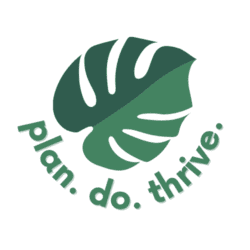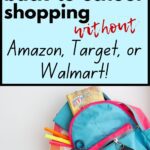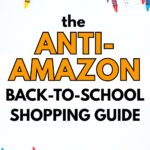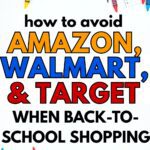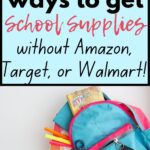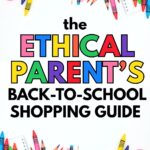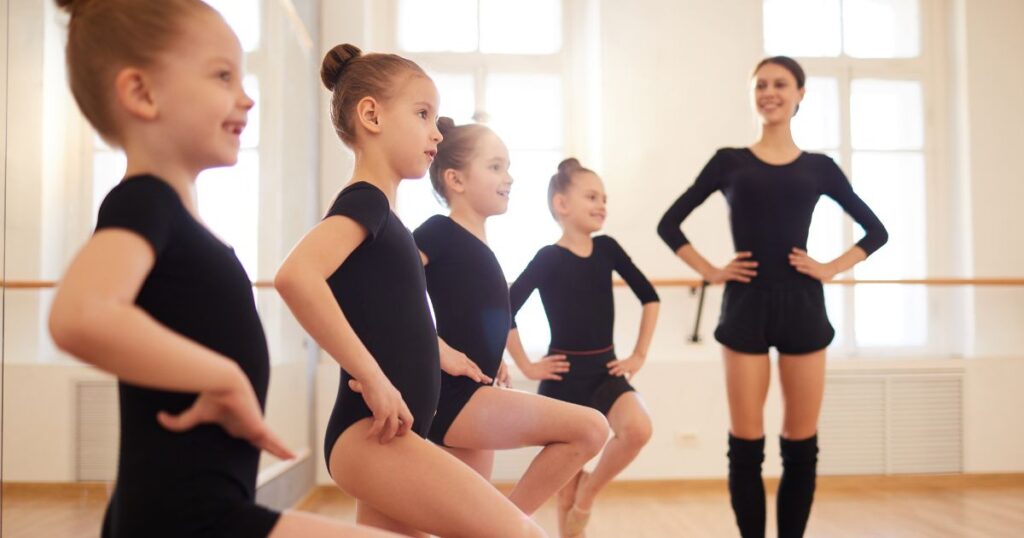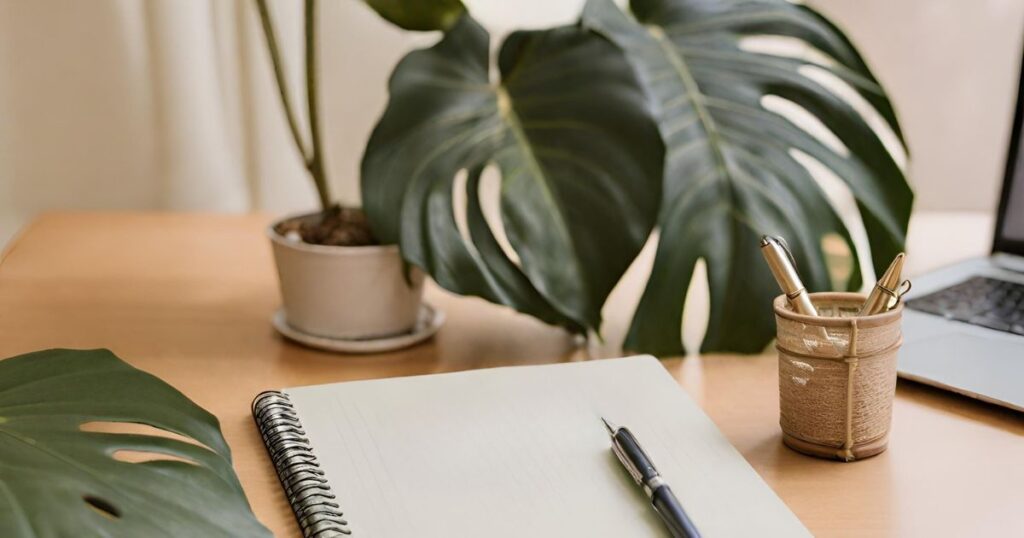Boycotting Amazon, Target, and Walmart but still need school supplies?
It’s a little overwhelming – I get it. It’s my first year avoiding these retailers altogether, too! You’re in the right place.
This is important work, to continue the now-permanent and/or rolling boycotts of these big box stores. Amazon, Target, and Walmart are among other retailers known for tax avoidance, union-busting, warehouse conditions in extreme heat, worker exploitation, low worker pay, corporate subsidies, price manipulation, lobbying against workers’ rights, anti-DEI, profiting from surveillance and data about you, and otherwise not serving the people. And when you and I choose not to shop at these stores, we make a difference. They’re effective. It works. Target’s first-quarter earnings this year showed a decline, and share price fell from 30% from February to June. Amazon is seeing low sales from Prime Day this year. By voting with our dollars, we hold corporations accountable for their greed.
But that does mean resetting our shopping habits, which can be a challenge for parents who have multiple people to shop for and ever-changing needs. Here’s our guide to back-to-school shopping that avoids putting money in the pockets of billionaires.
First: what school supplies do you actually need?
As I work to reset my shopping impulses, it’s helpful to pause and consider what I actually need. It’s all too easy to mindlessly buy items because you see them, or think you might need them, or because they look pretty. By reconsidering and shopping more consciously, I’ve been able to avoid mindless purchases. This allows me to save money, giving less to corporations and the mega-rich, while also saving myself time and hassle.
Remember: it’s the job of marketers and advertisers to make you think you need things, and they often do so by creating a day or season of shopping, whether that’s Prime Day, Back-to-School shopping, Black Friday, or any sale. You can choose not to get swept up in it.
For example, take clothes. It can be tempting to buy a whole new wardrobe when school starts. But presumably your kids have been wearing clothes the year thus far (naked toddlers as perhaps an exception), so they have clothes they can wear to school. Of course, get your child clothing if they’ve sized up or worn through their current options, and make sure they’re prepared for cooler and wetter weather ahead. But don’t buy anything just because it’s the new school year. That’s not necessary.
To that end, I would recommend only shopping for the items on the official school supply list provided by your school. In addition to that list, if your child’s backpack, water bottle, or lunch box from last year is no longer usable, then add that item to your list. That’s it! That’s all you need in advance. You’re ready for the first day of school. If you realize that something else is necessary later on, you can obtain it then.
Take the old saying to heart: Use it up, wear it out, make it do or do without.
General resources for school supplies
Now, as for the supplies on the school-provided school supplies list, where can you get those besides Amazon, Walmart, and Target?
Your home
While it’s tempting to buy new supplies for a new school year, the most environmentally friendly, wallet-friendly, and dare I say, easiest way to prepare is to use the items you already own. Make sure you “shop” your home first, including your child’s room and anywhere you keep office and craft supplies. Don’t forget to look in their backpacks from last year!
Supplies that are easily re-used from year to year include:
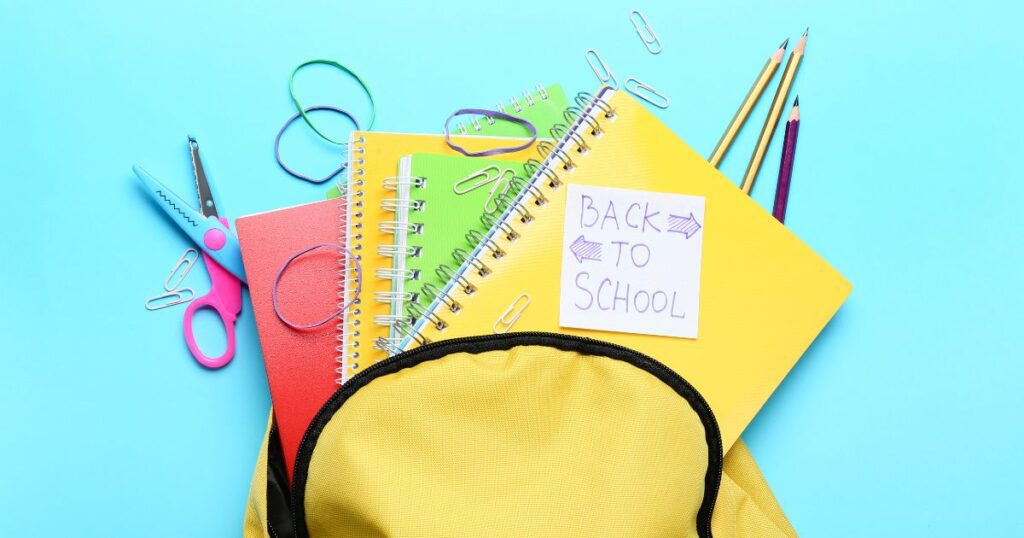
- Scissors
- Rulers
- Pencil boxes
- Pencil sharpeners
- Headphones
- Backpacks
- Water bottles
- Lunch boxes and accessories
- Clothing
- Pencils, erasers, markers, dry-erase markers, highlighters, crayons, colored pencils, textbook covers, binders, and folders that survived well from last year’s use. Obviously with kids, many of these items see a lot of wear, but others may have sat in their desks at school or at home for most of the school year.
Plus, you may have more consumable items on hand that never did get used, such as:
- Pencils
- Folders
- Post-its
- Paper
- Disinfecting wipes
- Glue sticks
- Crayons
- Colored pencils
- Markers
- Highlighters
- Dry-erase markers
- Tissues
- Hand sanitizer
- Erasers
- Index cards
- Notebooks and composition books – I know we have several with only a few pages used that could easily be sent again this year.
Community sharing groups
After you shop your own home, it’s time to see what your neighbors have and are willing to share for free. I talk a lot on here about Buy Nothing groups. Buy Nothing communities are extremely small and local groups focused on giving away items you aren’t using to others in your community for reuse, to reduce consumption and save money. You can find your local Buy Nothing group here, which may be on Facebook or via the Buy Nothing app. Similar communities can be found on Freecycle, free items on NextDoor, free items on Facebook marketplace, and Facebook groups focused on freebies (which are often sharing marketplace postings, but not always).
If you’ve never used a group like these, you may be surprised by how high of quality/value items that folks are willing to give away. It’s often coordinated through a message and a simple porch pickup.
Check the rules of your group and see if requests are allowed. If so, you may be able to post requesting the specific items you’re searching for. I’ve gotten items this way as well, and given things away that my neighbors requested.
Resale marketplaces
Once you’ve exhausted your free options, check resale marketplaces. Don’t be fooled, though: you can often find new, unused items this way for a discount. I would check:
- Ebay – for example, search school supply lot or look up specific items you’re shopping for.
- Facebook marketplace – you have the option to search nearby items for pickup, or search anywhere for shipping.
- Thrift stores – not just for clothing and housewares! At the thrift stores I frequent, you can find items such as school/office supplies, along with craft supplies and small housewares and toys, in clear plastic bags hanging on racks or the wall. This is a great way to give items a second life for a good price. I’ve also found some new and barely-used backpacks and lunchboxes at thrift stores.
- Mercari – an online resale marketplace. It’s pretty straightforward, and unlike a lot of the marketplaces, does not focus on clothes but is more broadly inclusive of all sorts of items. I see a ton of listings of school supplies of all sorts. Use this link for $10 off your first purchase.
Ethical shopping guide for back-to-school supplies
There are plenty of ways to buy new school supplies that don’t involve the mega-corporations. Here are a few stores I recommend.
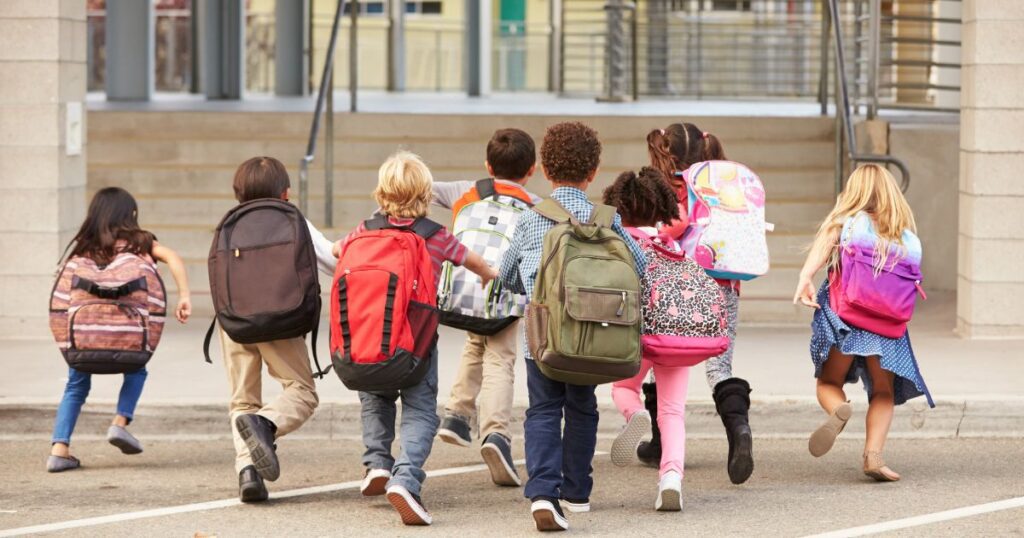
- Independent brick-and-mortar stores near you – seek out independent small businesses near you. For school supplies, you might try grocers, bookstores, and gift boutiques. I am lucky enough to live near a Zero Waste store – see if there’s one near you. Ask around in local forums online to find favorite small businesses.
- Etsy – great for items you may want personalized, handmade, or artsy versions of, like pencil cases, folders, custom pencils, or washable labels you can put on clothes and supplies. It’s great to support artists. Just be wary when looking at items and reviews and make sure the item actually seems handmade, as some sellers are using Etsy as a platform to resell cheap goods from places like AliExpress. Note: Etsy is under scrutiny right now for failing to block Alligator Alcatraz merch from their platform, so you may choose to add them to your boycott list.
- Earth Hero – a great resource especially for sustainable supplies to lower your environmental impact. Check out their decomposition book, colored pencils, recycled rubber erasers, plant-based glue sticks and liquid glue, beeswax crayons, and recycled paper sticky notes.
- Bookshop.org – Bookshop.org supports independent bookstores, and I’ve long used them for physical book purchases. Beyond books, you can also find basic or decorative pencils, colored pencils, scissors, composition books, etc. –– here’s a list with links.
- Grove collaborative – a B-corp that focuses on sustainable options. Check out their colored pencils, composition books, plant-based glue sticks, recycled plastic scissors, beeswax crayons, and the rest of their school supplies.
- Costco – Costco is often lauded for treating its employees well with higher than average wages and more comprehensive benefits than other large corporations. You’ll need a membership to shop there. Then, you’ll be able to find most items you’ll need like paper, notebooks, folders, pencils, coloring supplies, scissors, tissues, post-its, tape, etc.
- Wegmans – Wegmans is another grocer known for treating its workers well. You can find all the usual school supplies there, such as scissors, notebooks, pencils, pens, folders, etc.
A last word of advice: I asked a teacher her #1 tip for preparing school supplies and she said, please sharpen the pencils in advance!
Cheers to a great school year ahead.
Up next: 5 digital planning tips for a smooth back-to-school
Or read on for Christmas shopping while boycotting Amazon, Walmart, and Target
